
Giuseppe Arcimboldo stands as one of the most intriguing and unconventional figures in the history of Western art. Active during the late Renaissance, a period often characterized by its pursuit of classical harmony and idealized naturalism, Arcimboldo forged a unique path. He is celebrated, almost singularly, for his extraordinary composite portraits – heads and figures ingeniously constructed from meticulously rendered objects, primarily fruits, vegetables, flowers, and animals. These works, brimming with wit, allegory, and a deep fascination with the natural world, secured him fame in the Habsburg courts of Vienna and Prague but later led to centuries of relative obscurity before his enthusiastic rediscovery in the 20th century. As an artist straddling Mannerism and anticipating concepts later explored by Surrealism, Arcimboldo's life and work offer a fascinating glimpse into the intellectual currents and artistic possibilities of his time.
Milanese Roots and Early Career
Giuseppe Arcimboldo was born in Milan around 1526 or 1527 into a distinguished family. His father, Biagio Arcimboldo, was also a painter, providing Giuseppe with his initial artistic training. The artistic environment of Milan in the mid-16th century was still deeply influenced by the legacy of Leonardo da Vinci, who had spent significant periods working in the city. While direct tutelage is unproven, the Milanese emphasis on detailed observation of nature and a certain penchant for the curious and complex, legacies partly attributable to Leonardo and his followers like Bernardino Luini, likely shaped the young Arcimboldo's artistic sensibilities. His connection to Leonardo's circle is further suggested by his association with Bernardino Campi, another prominent Lombard painter influenced by the High Renaissance master.

Arcimboldo's early documented career began in the 1540s, not initially with easel painting, but with more traditional forms of artistic production. He received commissions for designing stained glass windows and tapestries for the Duomo (Cathedral) of Milan. Working on cartoons for the Life of Saint Catherine of Alexandria cycle for the Duomo from 1549, alongside his father, honed his skills in composition and design. He continued this work through the 1550s, also collaborating on frescoes for the Cathedral of Monza in 1556. This early work, though conventional compared to his later output, established his reputation as a skilled craftsman and designer within the Milanese artistic community.
These formative years provided Arcimboldo with a solid grounding in Renaissance techniques and aesthetics. His work on large-scale designs for stained glass and tapestry likely developed his ability to organize complex compositions and manage intricate details – skills that would prove essential for the elaborate construction of his later composite heads. While working within established religious and narrative frameworks, the seeds of his later inventiveness may have already been germinating, awaiting a context that would encourage their full expression.
The Call to the Habsburg Court
A pivotal moment in Arcimboldo's life occurred in 1562 when he was summoned to the Habsburg court, initially in Vienna. He was called into the service of Ferdinand I, the Holy Roman Emperor. Following Ferdinand's death in 1564, Arcimboldo continued his service under Emperor Maximilian II and later, most significantly, under Maximilian's son, Emperor Rudolf II. He would spend approximately 25 years in imperial service, primarily moving between Vienna and Prague, the latter becoming the imperial capital under Rudolf II in 1583. This move from Milan to the heart of the Holy Roman Empire was transformative, placing Arcimboldo in one of Europe's most intellectually vibrant and artistically stimulating environments.
The Habsburg emperors, particularly Maximilian II and Rudolf II, were renowned patrons of the arts and sciences. Their courts were cosmopolitan centers attracting artists, scholars, scientists, alchemists, and philosophers from across Europe. Maximilian II had a keen interest in botany and zoology, establishing menageries and botanical gardens. This imperial fascination with the natural world provided fertile ground for Arcimboldo's unique talents. His ability to render natural elements with scientific precision, combined with his imaginative flair, resonated deeply with the court's intellectual climate.

It was during his early years at court, likely under Maximilian II, that Arcimboldo began creating the composite portraits that would define his legacy. The precise impetus for these inventions remains debated – perhaps a personal fascination, a response to the Mannerist taste for the bizarre and ingenious (capricci), or a specific commission designed to amuse and impress the emperor and his circle. Whatever the origin, these works were immediately successful, showcasing not only artistic skill but also wit and intellectual depth, qualities highly prized in courtly culture.
The Invention of the Composite Head
Arcimboldo's most celebrated contribution to art history is the composite head, a form of portraiture where the subject's likeness is constructed entirely from other objects. These objects were often related thematically – fruits and vegetables for seasons, animals for elements, books for a librarian, legal documents for a jurist. The genius of these works lies in the dual reading they demand: from a distance, they resolve into a recognizable human (or humanoid) face, often a profile portrait; up close, they dissolve into a meticulously painted collection of individual items.
This style is deeply rooted in the Mannerist period (roughly 1520-1600), which followed the High Renaissance. Mannerism often involved a self-conscious display of artifice, intellectual complexity, visual puzzles, and a departure from the naturalism and classical balance of artists like Raphael. Artists such as Bronzino, Pontormo, and Parmigianino explored elongated forms, complex poses, and psychological intensity in their portraits. Arcimboldo's work shares Mannerism's love for ingenuity (ingegno), wit (acutezza), and the unexpected (maraviglia), but his approach was entirely novel. He wasn't just stylizing the human form; he was fundamentally reconstructing it from non-human elements.
The objects Arcimboldo chose were rendered with remarkable accuracy, reflecting the era's burgeoning interest in empirical observation and natural history, perhaps influenced by the detailed nature studies of Northern Renaissance artists like Albrecht Dürer. Yet, these were not mere still lifes arranged into a face. The selection and placement of each element were carefully considered to contribute to the overall likeness, character, and symbolic meaning of the portrait. A gnarled tree root might form a nose, ripe cherries the lips, a pea pod an eyelid. This intricate interplay between the individual components and the composite whole created a visual riddle that delighted his sophisticated courtly audience.
Masterpieces: The Four Seasons
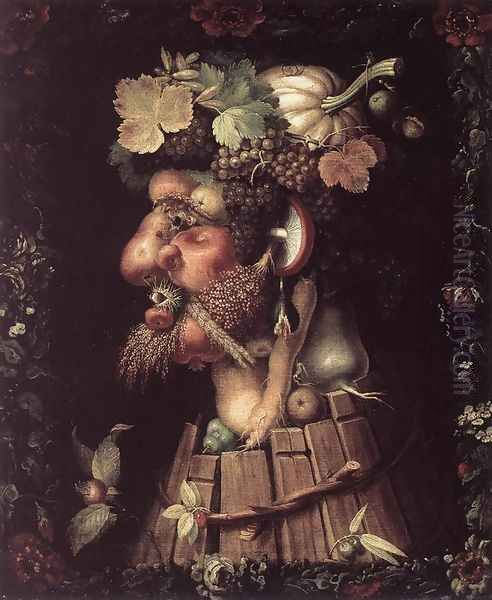
Among Arcimboldo's most famous works are the series representing the Four Seasons. He painted several versions of this theme, the earliest known set dating from 1563, created for Maximilian II. These paintings personify each season through arrangements of plants, flowers, and fruits characteristic of that time of year. They function both as allegorical portraits and as celebrations of nature's cyclical bounty, implicitly linking the prosperity and order of the natural world to the stability and power of the Habsburg reign.
Spring (1563, Real Academia de Bellas Artes de San Fernando, Madrid) is typically depicted as a young woman composed entirely of fresh flowers. Roses form her cheeks and hair, daisies and other blossoms create her dress and adorn her head, suggesting youth, beauty, and renewal. The level of botanical detail is astonishing, showcasing Arcimboldo's deep knowledge of flora.
Summer (1563, Kunsthistorisches Museum, Vienna) is often shown as a figure constructed from summer fruits and vegetables. Peaches form the cheeks, cherries the lips, cucumbers the nose, and an artichoke the heart. The figure wears a tunic woven from wheat, with the artist's signature and the date appearing on the collar. This personification radiates warmth and abundance, capturing the height of the growing season.
Autumn (1573, Louvre Museum, Paris) presents a more mature, somewhat rustic face made from autumnal produce. A pear forms the nose, a pomegranate the chin, mushrooms the ear, and grapes cascade as hair. The figure's torso is constructed from wooden barrel staves, reinforcing the association with harvest time and winemaking. The expression is often robust and slightly weathered.
Winter (1563, Kunsthistorisches Museum, Vienna) is portrayed as an old, gnarled figure composed primarily of a barren tree trunk. Ivy and moss cling to the form, suggesting age and decay, while a lemon and orange, winter fruits, hang from the chest like pendants. The face is formed from bark, roots, and fungi. It conveys a sense of dormancy and the harshness of the season, yet also the resilience of life waiting to re-emerge.
These paintings were often presented as gifts to other rulers or displayed in the Emperor's Kunstkammer (cabinet of curiosities), highlighting the Habsburgs' dominion over nature and the harmonious cycle of life under their rule. The combination of naturalistic detail, allegorical depth, and sheer invention made The Four Seasons enduringly popular.
Masterpieces: The Four Elements
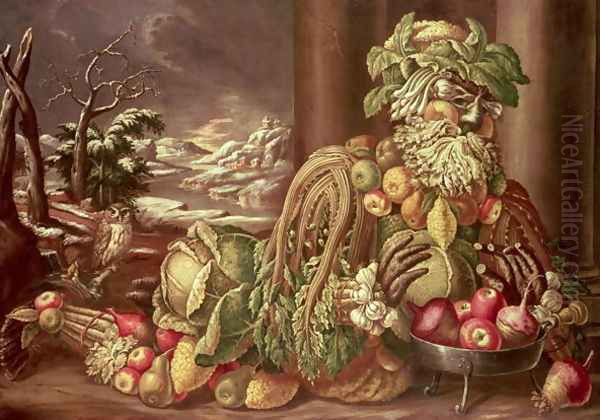
Complementing The Four Seasons, Arcimboldo created a series personifying the Four Elements – Air, Earth, Fire, and Water. Painted around 1566, also for Maximilian II, this series extended the allegorical framework, linking the human form (microcosm) to the fundamental components of the universe (macrocosm). Like The Four Seasons, these works implicitly celebrated the Emperor's power as extending over all aspects of the created world.
Air (c. 1566, private collection) is composed entirely of birds. An eagle might form the cheek, a peacock the neck and chest, and numerous smaller birds cluster together to create the hair and features. The effect is light, dynamic, and slightly ethereal, capturing the nature of the element.
Earth (c. 1566, private collection, copy in Kunsthistorisches Museum, Vienna) is constructed from various land animals. An elephant forms the cheek, a deer the neck, a wolf the forehead, and other creatures like lions, sheep, and foxes are intricately woven into the composition. The overall impression is solid, powerful, and grounded.
Fire (1566, Kunsthistorisches Museum, Vienna) is perhaps the most dramatic of the series. It is formed from objects associated with fire and light: burning embers and logs create the hair and cheek, a candle forms the nose, flints make up the neck, and firearms (like a cannon barrel and pistol) constitute the chest and shoulder. The Habsburg Order of the Golden Fleece hangs prominently, directly linking the fiery power to the Emperor.
Water (1566, Kunsthistorisches Museum, Vienna) is a composite of marine creatures. Fish of various species, coral, shells, a seal, and perhaps even a pearl necklace form the figure. The skin has a damp, glistening quality, and the overall effect is cool, fluid, and slightly unsettling, capturing the mysterious depths of the aquatic realm.
When displayed together, The Four Seasons and The Four Elements created a complex allegorical program. Often, The Seasons were arranged on one wall and The Elements on the opposite, suggesting a correspondence between them (e.g., Winter opposite Water, Summer opposite Fire). This reinforced the idea of a divinely ordained, harmonious universe under the wise rule of the Habsburg Emperor.
Portraits of Power, Play, and Profession

Beyond the grand allegorical series, Arcimboldo applied his composite technique to portraits of specific individuals or types, often with satirical or symbolic intent. One of his most famous later works is Vertumnus (c. 1590-1591, Skokloster Castle, Sweden), a portrait of Emperor Rudolf II depicted as the Roman god of seasons, change, and plant growth. The Emperor's face and body are masterfully composed of a profusion of fruits, flowers, and vegetables from all seasons, symbolizing the abundance and harmony of his reign and his dominion over nature. It is both a flattering imperial portrait and a stunning display of Arcimboldo's mature style.
Other works explored professions and human types. The Librarian (c. 1566, Skokloster Castle, Sweden) portrays a figure constructed entirely from books. Stacks of volumes form the torso and head, bookmarks become hair or fingers, and spectacles rest upon a pile of pages forming the nose. While seemingly a straightforward representation, some interpretations suggest a commentary on scholars who are perhaps more defined by their books than by their humanity.
Similarly, The Jurist (or The Lawyer) (1566, Nationalmuseum, Stockholm) presents a stern face composed of plucked poultry and fish, with legal documents forming the body. The expression is severe and perhaps unflattering, possibly a satirical take on the legal profession. The ambiguity – is it praise or critique? – is characteristic of Mannerist wit.
Arcimboldo also experimented with reversible images, or "puzzle pictures." The Vegetable Gardener (or Ortolano) (c. 1590, Museo Civico Ala Ponzone, Cremona) appears as a simple bowl of vegetables when viewed normally. However, when inverted, the arrangement startlingly resolves into the face of a gardener. A similar trick is employed in The Cook (c. 1570, Nationalmuseum, Stockholm), where a platter of roasted meats transforms into a chef's face when turned upside down. These playful works further demonstrate Arcimboldo's fascination with perception, illusion, and visual games, catering to the court's love for cleverness and novelty.
Arcimboldo the Courtier: More Than a Painter
Arcimboldo's role at the Habsburg court extended far beyond painting composite heads. He was a versatile court artist and functionary, involved in various aspects of court life and entertainment. His official title included that of court painter, but his activities suggest a broader portfolio, akin to a modern creative director for the imperial household.
He was commissioned to design elaborate costumes, masks, and floats for court festivals, tournaments, pageants, and theatrical performances. These events were crucial elements of courtly representation, displaying the Emperor's wealth, power, and cultural sophistication. Arcimboldo's inventive designs, likely echoing the fantastical nature of his paintings, would have contributed significantly to the splendor and maraviglia of these occasions. Records mention his involvement in organizing a grand tournament for the Archduke Ernest's wedding in 1571.
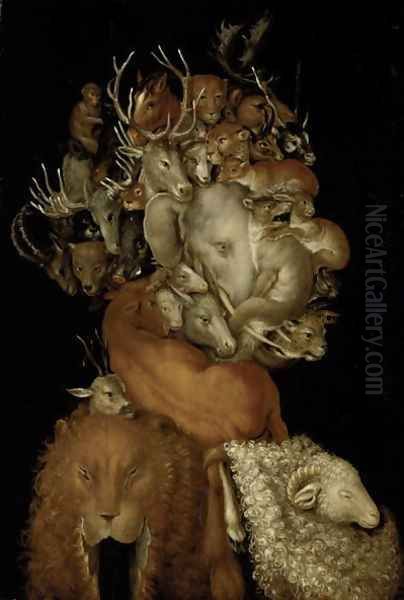
Furthermore, Arcimboldo was reportedly involved in designing hydraulic systems and water features for the imperial residences, showcasing an interest in engineering and mechanics. There are also accounts, though sometimes debated, of him inventing curious devices, such as a "color harpsichord" or similar instrument intended to translate musical notes into colors, reflecting the era's interest in synesthesia and the correspondences between the senses – interests particularly strong in the esoteric atmosphere of Rudolf II's Prague.
He also acted as an agent for the Emperor in acquiring artworks and antiquities, contributing to the vast and eclectic collections housed in Rudolf II's famous Kunstkammer. His long service and diverse talents made him a trusted and valued member of the imperial inner circle. His elevation to the rank of Count Palatine by Rudolf II in 1592, shortly after his return to Milan, was a testament to the high esteem in which he was held.
Artistic Context and Contemporaries
To fully appreciate Arcimboldo's achievement, it's essential to place him within the broader context of 16th-century European art. His work is undeniably Mannerist in its emphasis on artifice, complexity, allegory, and intellectual wit, aligning him with Italian contemporaries like Bronzino, Pontormo, Parmigianino, and perhaps even the sculptor and goldsmith Benvenuto Cellini, known for his intricate and luxurious creations. However, Arcimboldo's specific method of composite portraiture remains unique.
His detailed rendering of natural elements connects him to the Northern European tradition of meticulous observation, exemplified by Albrecht Dürer. While in Prague, Arcimboldo would have encountered a wide range of art, including the works of Northern masters collected by the Habsburgs. He is known to have studied the fantastical and often grotesque imagery of Hieronymus Bosch and the peasant scenes and allegories of Pieter Bruegel the Elder, whose works were highly prized by Rudolf II. The influence of Bosch's imaginative creatures and Bruegel's interest in allegory and human folly can perhaps be detected in the sometimes unsettling or satirical undertones of Arcimboldo's creations.
His early Milanese background connected him to the legacy of Leonardo da Vinci, particularly the interest in physiognomy, caricature, and the detailed study of nature found in Leonardo's notebooks. Artists like Bernardino Luini and Bernardino Campi carried forward aspects of Leonardo's style in Lombardy, forming part of the artistic milieu in which Arcimboldo initially trained.
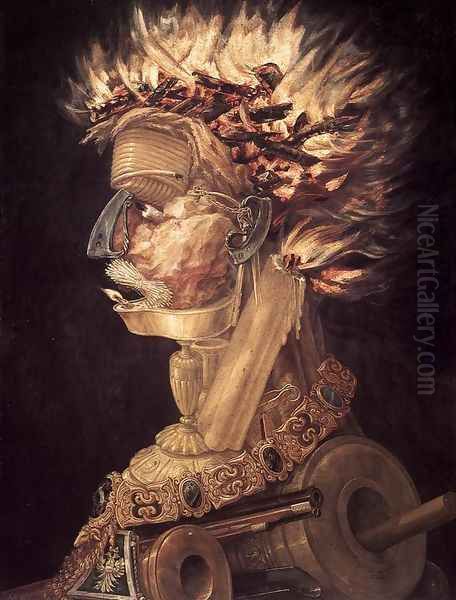
Compared to the dominant portraiture style of the High Renaissance (e.g., Raphael) or the Venetian school (e.g., Titian), Arcimboldo's work seems deliberately anti-classical and anti-naturalistic in its conceptual premise, even while employing highly naturalistic rendering for the individual components. He prioritized the intellectual conceit and the visual puzzle over straightforward representation or idealized beauty. This playful, cerebral quality made his work perfectly suited to the sophisticated, somewhat esoteric tastes of the Habsburg court, particularly under the introspective and curious Rudolf II.
Later Life and Return to Milan
After approximately 25 years of dedicated service to the Habsburg emperors, Arcimboldo sought permission to return to his native Milan. Rudolf II granted his request in 1587, but Arcimboldo continued to work for the Emperor even after leaving Prague. It was during this final period in Milan that he painted one of his most celebrated masterpieces, the portrait of Rudolf II as Vertumnus (c. 1590-1591), which he sent back to the appreciative Emperor in Prague.
His return to Milan marked the culmination of a highly successful career. He was a renowned artist, internationally recognized through his association with the imperial court. In 1592, Rudolf II bestowed upon him the prestigious title of Count Palatine, a significant honor recognizing his artistic achievements and loyal service. This title elevated his social standing and confirmed his status as one of the leading artists of his time.
In Milan, Arcimboldo reconnected with the city's artistic and literary circles. He was praised by contemporary writers and theorists like Gregorio Comanini, who discussed Arcimboldo's work in his treatise Il Figino (1591), highlighting the wit and ingenuity of his composite inventions. This period seems to have been one of relative peace and continued artistic activity, allowing him to enjoy the fruits of his long and distinguished career.
Giuseppe Arcimboldo died in Milan on July 11, 1593. He passed away at the height of his fame, recognized by one of Europe's most powerful rulers and admired by his contemporaries for his unique artistic vision.
Obscurity and Rediscovery: The Enduring Legacy
Despite the fame Arcimboldo enjoyed during his lifetime, his work fell into relative obscurity following his death and throughout the 17th, 18th, and 19th centuries. The changing tastes of the Baroque, Rococo, and Neoclassical periods found little resonance in his Mannerist conceits. His composite heads were often dismissed as mere curiosities, bizarre jokes, or eccentricities lacking serious artistic merit. While his paintings remained in collections, notably the imperial collections in Vienna and Prague (and later dispersed to other museums like the Louvre and Skokloster Castle), they were largely overlooked by mainstream art history.
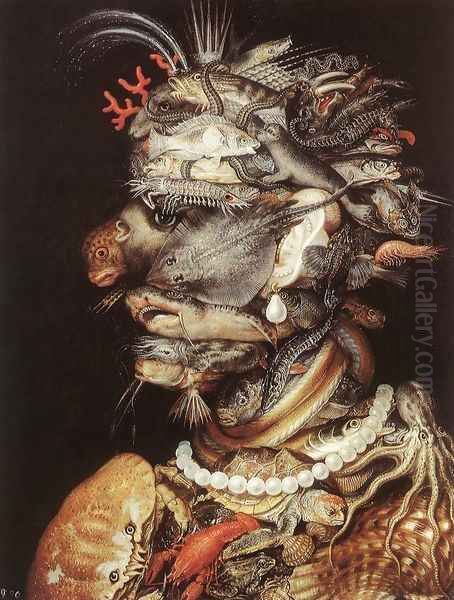
The dramatic rediscovery and reappraisal of Arcimboldo occurred in the early 20th century, primarily through the enthusiasm of the Surrealist artists. Figures like Salvador Dalí, Max Ernst, and René Magritte saw in Arcimboldo a kindred spirit – an artist who explored the irrational, the dreamlike, the transformation of objects, and the unsettling juxtaposition of the familiar and the strange. Dalí, in particular, was fascinated by Arcimboldo's visual puns and metamorphic imagery, which resonated with his own "paranoiac-critical method." Arcimboldo was hailed as a precursor to Surrealism, a visionary who had anticipated their artistic concerns centuries earlier.
This Surrealist connection brought Arcimboldo firmly back into the art historical spotlight. Exhibitions, scholarly studies, and reproductions of his work proliferated. He was no longer seen as just an eccentric court painter but as a highly original artist whose work engaged with complex ideas about perception, nature, allegory, and the very definition of representation.
His influence extends beyond Surrealism. Contemporary artists continue to draw inspiration from his composite technique and playful approach to imagery. Artists like Shigeo Fukuda, Octavio Ocampo, Sandro del Prete, and Bernard Pras have explored similar themes of illusion, transformation, and assemblage in their own diverse styles. Arcimboldo's work has also permeated popular culture, appearing on album covers (like Kansas's Masque, featuring Water) and book jackets (such as Thomas Szasz's The Myth of Mental Illness, using The Librarian), demonstrating its enduring visual appeal and symbolic resonance.
Conclusion: A Master of Transformation
Giuseppe Arcimboldo remains a unique figure in art history, an artist whose primary mode of expression – the composite head – was largely his own invention and mastery. Rooted in the intellectual curiosity and Mannerist aesthetics of the late 16th century, his work brilliantly combines meticulous observation of the natural world with fantastical imagination. His portraits made of fruits, flowers, animals, and objects are more than mere visual tricks; they are complex allegories reflecting on nature, power, human identity, and the very act of perception.
Serving the Habsburg emperors, particularly the erudite Rudolf II, provided Arcimboldo with the ideal environment to develop his singular talent. His paintings delighted a sophisticated audience attuned to wit, symbolism, and the wonders of the natural world. While subsequent centuries largely forgot him, his rediscovery in the 20th century cemented his status as a significant artist, a master of Mannerism whose imaginative vision anticipated key aspects of modern art, particularly Surrealism. Arcimboldo's legacy lies in his ability to transform the ordinary into the extraordinary, inviting viewers to look closer and see the world, and the human face, anew.